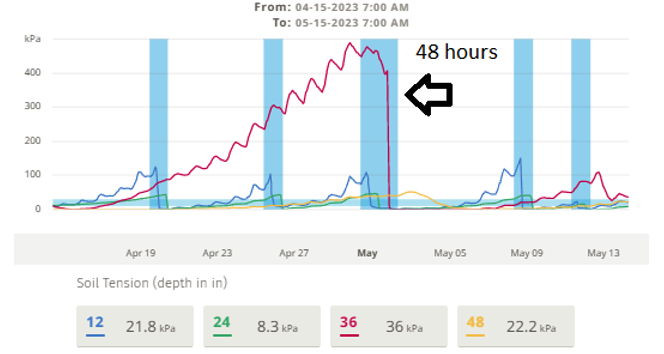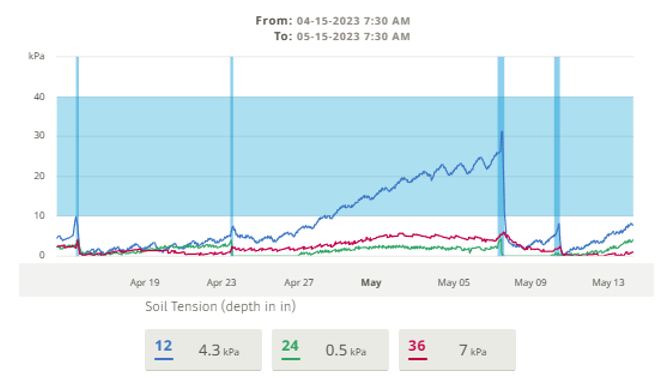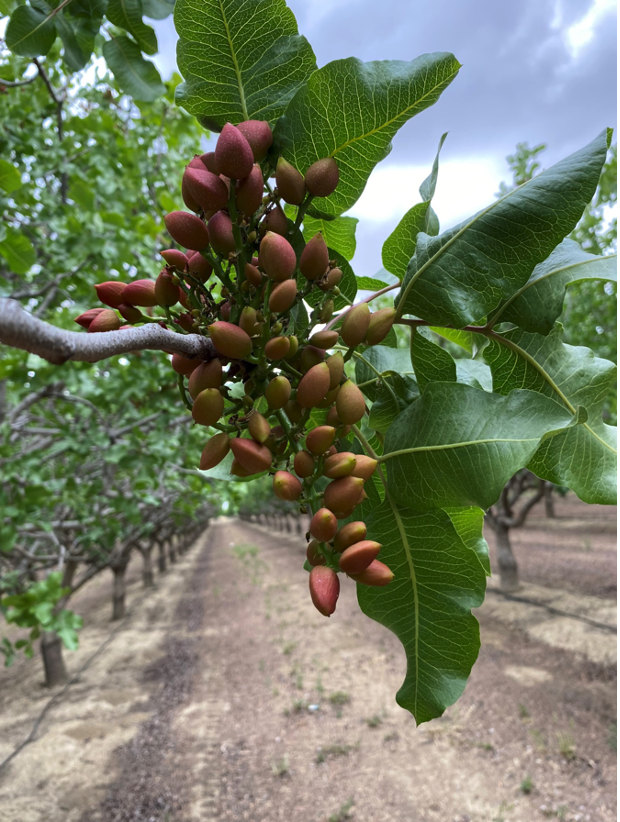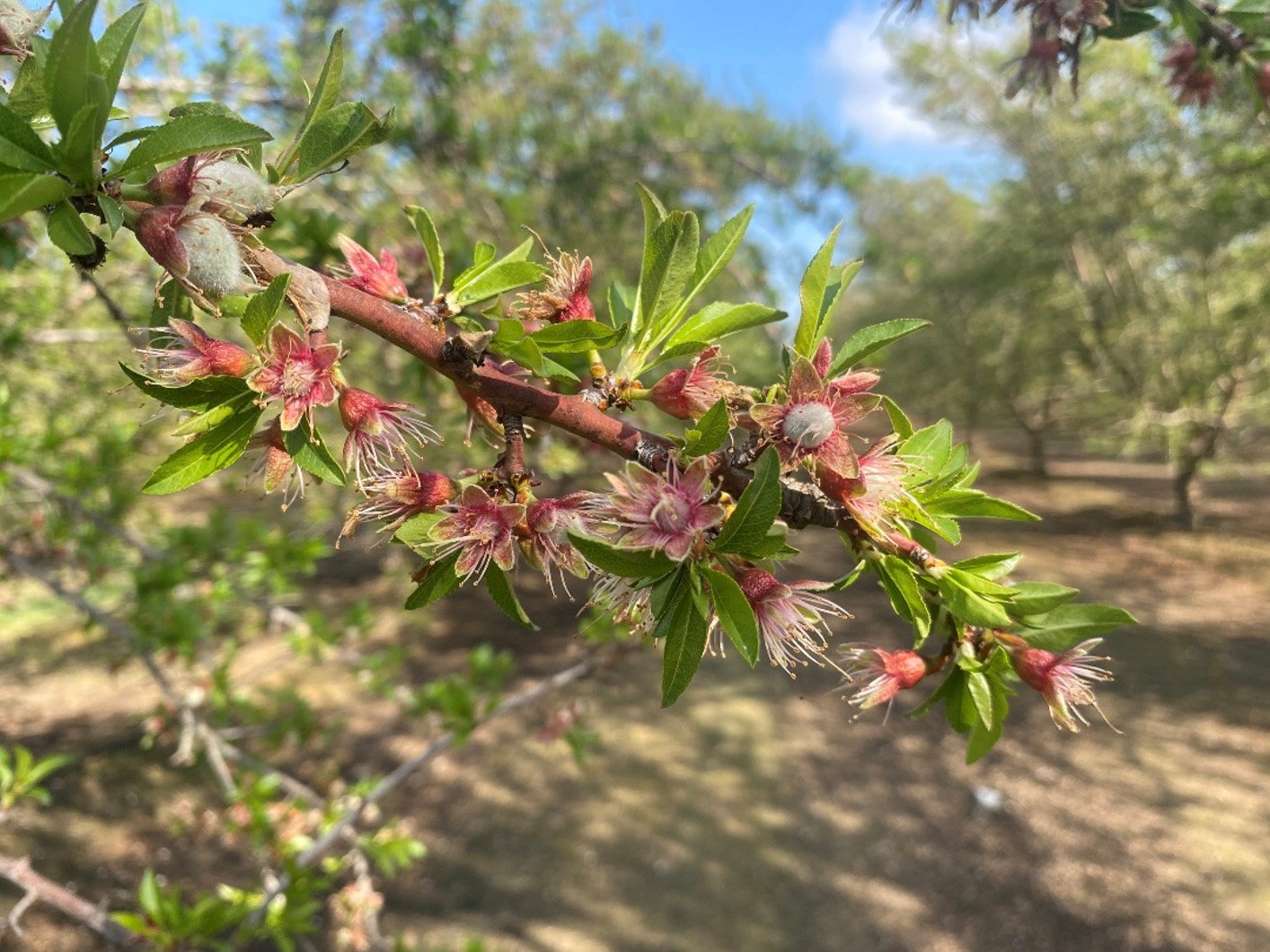By Derek Toschi, CCA, CAIS
With a cooler spring and wet winter, the 2023 California pistachio crop faces different challenges than previous years. The cooler weather has delayed the crop in many parts of the state and the March rain kept soil saturated longer into the season and lowered early season irrigation requirements. Irrigation timing during the spring has been very important to avoid bloom drop and maximize early season root and vegetative growth. Now with the crop continuing hull expansion, as of mid-May, pistachio growers will need to optimize their irrigation strategies to get the most of this year’s crop. In this post we are going to be assessing the irrigation needs of this year’s crop in two different situations and discuss irrigation tips going forward.
First, let’s look at a pistachio crop that is further along than much of the state. These are Golden Hills near Coalinga, an area that routinely has an earlier crop. This field uses a single drip hose with 3 emitters per tree which allows them to push salts away from the trees which is a big issue with the groundwater in this area.

This crop came out of bloom with a very strong water demand. We were applying 24 hours every week coming out of bloom to continually rehydrate the top 24” of soil where soil tension was rising quickly through the blue band between irrigations. The 24-hour applications weren’t percolating through this heavy clay soil and the soil tension at 36” continued to rise. To replenish the soil moisture deficit at 36”, a 48-hour application was mixed in early May which percolated vertically past 36” and soil tension at 36” and 48” dropped back into the blue band, below 40 kPa. As the leaves continued to expand and the crop is requiring more water, this field is now receiving two applications per week but is still receiving mostly 24-hour applications to manage soil tension in the more active top 24” soil horizon. 48-hour applications will be mixed in over the next several weeks during shell hardening to replenish the soil moisture deficit at 36” and bring soil tension back below 40 kPa. Right now, water demand isn’t high enough to warrant 48-hour applications every time its irrigated.
Next let’s look at a very different situation in a Golden Hills field west of Firebaugh. This crop is later than normal and water demand post bloom has been very slow. This field has very heavy soil next to a sump with a high-water table. This field is also irrigated with a single hose and has the same emitters as the last field we looked at. A few short applications were run during bloom for fertilizer but outside of those early applications the water was left off as the soil tension was much too low even as weather was warmer up and the leaves were expanding. This is a field where soil tension is rising much slower than normal for this time of year. The heavy spring rain contributes to this but also this very heavy soil needed a long time to dry out. We waited until the soil tension at 12” climbed through the blue band before our first application with clean water on May 7th. The 8-hour application percolated quickly and moved past 24” because the soil was already hydrated and less pore space needed to be refilled.


The recommendation for this field is to irrigate less than the calculated ET and allow the soil tension at 12” and 24” rise through the blue band to 40 kPa before the next application. Right now, we are only planning on running one 8-hour application per week to allow oxygen into the rootzone between applications.
Going into shell-hardening, this is a field we could apply a regulated irrigation deficit because we would be able to catch up before nut-fill due to the quick water percolation and already very wet soil past 24”.
Shell-hardening Irrigation Tips:
A common irrigation practice in pistachios is applying a mild irrigation deficit during shell-hardening. Shell-hardening usually starts in mid to late May and lasts through June. This is a period where the hulls have finished growing and the shell begins to lignify before kernel-fill. Research from the universities has suggested a mild irrigation deficit during this period can save water and not impact yield. I’ve found this to be mostly the case in practice as well, but I don’t recommend an irrigation deficit for every pistachio field.
- Avoid a regulated deficit irrigation strategy in multi-set irrigation systems.
- In fields that are irrigated in 3 or more sets, I’ve found applying an irrigation deficit during shell hardening to be a challenge because it takes too much time to catch up each irrigation set prior to nut-fill.
- Fields with good water infiltration and percolation are good candidates for a mild irrigation deficit.
- Fields with uniform soils that have very quick water percolation vertically can be caught up quite easily following a mild irrigation deficit. For these fields I recommend keeping the length of irrigations the same but adding an extra day between applications.
- Some mild stress is okay, a lot of stress is not.
- The emphasis here is on ‘mild’. This would be only waiting an extra day between irrigations or allowing the soil tension to rise 50 kPa more than you normally would. If your field is above 100 kPa for long periods of time, this is not a mild stress.
- If your trees are already under stress, applying more stress is not recommended.
- If you are already having difficulty in dropping the soil tension below 40 kPa or issues with slow water infiltration, adding more stress is not recommended.







